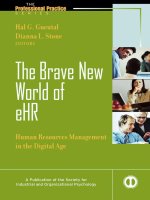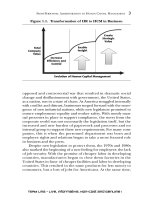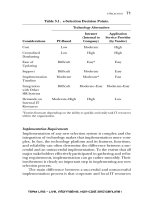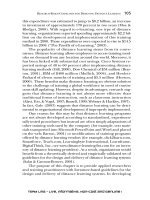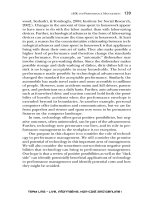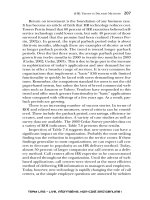Developing human resources in quang ninh province in the context of digital transformation
Bạn đang xem bản rút gọn của tài liệu. Xem và tải ngay bản đầy đủ của tài liệu tại đây (565.93 KB, 100 trang )
MINISTRY OF EDUCATION AND TRAINING
FOREIGN TRADE UNIVERSITY
------***------
MASTER THESIS
DEVELOPING HUMAN RESOURCES IN
QUANG NINH PROVINCE IN THE CONTEXT
OF DIGITAL TRANSFORMATION
MAJOR: INTERNATIONAL ECONOMICS
TA QUOC KHAI
HANOI - 2023
MINISTRY OF EDUCATION AND TRAINING
FOREIGN TRADE UNIVERSITY
------***------
MASTER THESIS
DEVELOPING HUMAN RESOURCES IN
QUANG NINH PROVINCE IN THE CONTEXT
OF DIGITAL TRANSFORMATION
Major: International Economics
Specialization: Master of Research in International Economics
Code: 8310106
Full name: Ta Quoc Khai
Supervisor: Assoc Prof, Dr. Hoang Xuan Binh
Ha Noi - 2023
i
STATEMENT OF ORIGINAL AUTHORSHIP
I hereby declare that this thesis was carried out by myself under the
guidance and supervision of Associate Professor, Dr Hoang Xuan Binh. I totally
affirm that the content and findings of this thesis are accurate and adhere to
research ethics. The data and figures presented were obtained through analysis,
comments, and evaluations from multiple sources, and were duly cited in the
reference section.
Additionally, any external comments, reviews, or data used from other
authors and organizations have been acknowledged and explicitly cited. The
author assumes full responsibility for any fraudulent activity discovered in the
thesis.
Author
(signature and full name)
ii
ACKNOWLEDGEMENTS
Words cannot express my gratitude to my Associate Professor, Dr Hoang Xuan Binh
and his invaluable patience and feedback. I also could not have undertaken this journey
without my defense committee, who generously provided knowledge and expertise.
Additionally, this endeavor would not have been possible without the generous support from
the Faculty of Graduate Studies of Foreign Trade University.
I am also grateful to my classmates and my friends, for their editing help, late- night
feedback sessions, and moral support. Thanks should also go to the librarians, research
assistants, and study participants from the university, who impacted and inspired me.
Finally, I must express my very profound gratitude to my parents for providing me
with unfailing support and continuous encouragement throughout my years of study and
through the process of researching and writing this thesis. This accomplishment would not
have been possible without them. Thank you.
iii
TABLE OF CONTENTS
STATEMENT OF ORIGINAL AUTHORSHIP........................................................ i
ACKNOWLEDGEMENTS...................................................................................... ii
LIST OF DIAGRAMS, FIGURES AND TABLES................................................... vi
SUMMARY OF THESIS RESEARCH RESULTS................................................. vii
INTRODUCTION..................................................................................................... 1
CHAPTER
1:
THEORETICAL
FOUNDATION
ON
DEVELOPING
PROVINCIAL HUMAN RESOURCES IN THE CONTEXT OF DIGITAL
TRANSFORMATION............................................................................................ 11
1.1. Some related concepts..................................................................................... 11
1.1.1. Concept of human resources.............................................................................. 11
1.1.2. Concept of human resources quality................................................................... 13
1.1.3. Criteria for evaluating the national workforce....................................................... 14
1.1.4. Developing human resources............................................................................. 15
1.1.5. Digital transformation....................................................................................... 16
1.2. Criterias for evaluating human resources in the province................................ 18
1.2.1. Criterias for evaluating the capacity of employees................................................ 18
1.2.2. Criteria for employees' mannerisms, conducts and obligations............................... 23
1.2.3. Criteria for evaluating employees based on their work performance.......................24
1.3. Digital transformation context and requirements of digital transformation
context..................................................................................................................... 25
1.3.1. Digital transformation context............................................................................ 25
1.3.2. Requirements of digital transformation context.................................................... 30
1.4. Experience in developing human resources of some provinces and cities...........33
1.4.1. Experience in developing human resources in Binh Thuan province......................33
1.4.2. Experience in developing human resources in Binh Duong province......................35
CHAPTER 2: THE CURRENT SITUATION OF HUMAN RESOURCES IN
QUANG
NINH
PROVINCE
IN
THE
CONTEXT
OF
DIGITAL
TRANSFORMATION............................................................................................ 38
2.1. Overview of natural and socio-economic conditions......................................... 38
iv
2.1.1. Geographical location........................................................................................ 38
2.1.2. Topographic..................................................................................................... 38
2.1.3. Climate............................................................................................................ 40
2.1.4. Economic context............................................................................................. 41
2.2. Analysis of the current situation of human resources in Quang Ninh province in
the context of digital transformation......................................................................... 42
2.2.1. Scale and structure of human resources............................................................... 42
2.2.2. Analyze the current situation of human resources................................................. 49
2.2.3. The subject’s role in developing human resources................................................ 53
2.2.4. Some policies and solutions of Quang Ninh province in developing human
resources………........................................................................................................ 56
2.3. Factors affecting human resources.................................................................. 58
2.3.1. Macro-environmental factors............................................................................. 58
2.3.2. Micro-environmental factors.............................................................................. 61
2.4. Assessment of the strengths and limitations human resources in Quang Ninh
province in the context of digital transformation....................................................... 62
2.4.1. Achievements................................................................................................... 62
2.4.2. Restrictions and causes...................................................................................... 64
CHAPTER 3: ORIENTATION AND SOME SOLUTIONS TO DEVELOP
HUMAN RESOURCES IN QUANG NINH PROVINCE IN THE CONTEXT OF
DIGITAL TRANSFORMATION........................................................................... 69
3.1. Orientation to develop human resources in Quang Ninh province in the context
of digital transformation........................................................................................... 69
3.1.1. Developing orientation of Quang Ninh province.................................................. 69
3.1.2. Requirements for the province's human resources in the context of digital
transformation........................................................................................................... 72
3.2. Some solutions to develop human resources in Quang Ninh province in the
context of digital transformation............................................................................... 75
3.2.1. Forecasting the needs in human resource in the context of digital transformation.....75
3.2.2. Raising awareness of digital transformation......................................................... 76
v
3.2.3. Building a learning society and learning organization........................................... 76
3.2.4. Prioritizing investment in human resource development in a number of industries and
fields……………….................................................................................................. 76
3.2.5. Training, allocation and the use of human resources must be closely related and
influence each other.................................................................................................... 76
3.2.6. Issueing policies to attract and support human resource training............................. 77
3.2.7. Other solutions................................................................................................. 79
3.3. Some policy recommendations........................................................................ 80
3.3.1. Policy on mobilizing resources for human resource development...........................80
3.3.2. Policy on employment, insurance and social protection......................................... 83
3.3.3. Policy on talented treatment............................................................................... 83
3.3.4. Policy on developing labor market...................................................................... 83
3.3.5. Some recommendations for competent state agencies........................................... 84
CONCLUSION....................................................................................................... 86
LIST OF REFERENCES........................................................................................ 88
vi
LIST OF DIAGRAMS, FIGURES AND TABLES
TABLES
Table 1. Scale of human resources in Quang Ninh province in 2019-2021.......................43
Table 2. Skill group classification................................................................................73
Table 3. Required Education and Skills for Digital Transformation.................................75
FIGURES
Figure 1. Diagram of the labor age structure in Quang Ninh province from 2019-2021
...................................................................................................................................50
Figure 2. Employment by type of economic in Quang Ninh province from 2019-2021
...................................................................................................................................52
vii
SUMMARY OF THESIS RESEARCH RESULTS
So far, Quang Ninh province's economy has heavily relied on industries that utilize
low-cost labor and exploit natural resources. The quality of human resources, particularly in
science and technology, remains limited. With the advent of Digital Transformation, these
limitations have worsened, particularly with regards to human resources. The author's
research aims to summarize the requirements of Digital Transformation for human
resources, assess the current human resources in Quang Ninh province, evaluate policies and
solutions implemented by the province to enhance human resource, and identify the
requirements of Digital Transformation for improving human resource. The thesis offers
solutions to boost human resources quality in Quang Ninh province to meet these demands.
1
INTRODUCTION
1. Rationale
Quang Ninh, a coastal province in Northeastern Vietnam, is a diverse area with a mix
of sea, islands, plains, midlands, hills, mountains, and borders. Due to its position as a key
economic zone in the North and a coastal zone of the Northern Delta, the province requires a
high-quality workforce to achieve rapid growth and narrow the gap in the knowledge-based
and globalized economy. This workforce must possess moral and intellectual qualities, a
desire to learn, creativity, cultural knowledge, and professional skills in production, business
capacity, macroeconomic management, and high-level scientific and technological expertise.
However, the current workforce does not meet the province's requirements for economic and
social development. To address this issue, Quang Ninh's Provincial Party Committee,
People's Council, and People's Committee have prioritized enhancing the workforce through
key and central leadership, flexible management, and positive solutions. The province's
strategy for socio-economic development emphasizes the development of a high-quality
workforce, with priority given to industries such as industry, trade, services, agriculture,
forestry, and fisheries with high levels of scientific and technological products, and marine
economic sectors. Ultimately, the success of Quang Ninh's economic and social
development goals depends on the quality of its workforce.
Studies have shown that, in addition to opportunities, the development of human
resources in Quang Ninh province also presents several new challenges, specifically in
several areas as follows:
Firstly, digital transformation will bring significant changes to various industries' labor
structure, causing traditional industries to disappear and new technology-related industries to
emerge. In a province with a large labor force, low- skilled labor will be easily replaced by
machines due to automation systems and intelligent robots. This situation will increase
unemployment and create a surplus of labor in developing economies. The coal mining
industry, for example, will be gradually replaced by modern machines and robots controlled
by advanced
2
technology, reducing the need for low-skilled labor. While digital transformation is creating
novel industries such as electronics, telecommunications, and 3D printing, jobs that involve
simple repetitive tasks and do not require training are being gradually substituted by robots.
Workers who lose their jobs due to automation and robotics will have to adapt to these new
industries that demand extensive knowledge and expertise. Nonetheless, changing
professions can be a difficult task.
Secondly, digital transformation will cause significant changes in the labor market,
resulting in polarization between low-skilled and high-skilled workers. The traditional
professions such as manual mining will disappear, and the need for low- skilled labor will
reduce due to the introduction of smart robots. Consequently, the labor market will be
divided into two categories of workers, low-skilled workers, and high-skilled workers, with
mid-skilled workers also facing a threat due to a lack of creative skills. As a result, the
requirement for highly skilled labor will increase with the rapid advancement of technology
in the future. The province can no longer rely on cheap labor as a competitive advantage
compared to other regions, and it is important to prepare for this change by improving
human resources through changes in training methods and requirements. Overall, the digital
transformation will have a significant impact on the labor market, necessitating a focus on
human resource training and preparation to meet the demands of the future.
Thirdly, under impacts of digital transformation, the demand for labor is increasingly
urgent and requires skilled and highly educated personnel. Meanwhile, the province's
workforce is currently deficient in both quantity and quality, especially in fields such as
information technology, computer engineering, automation, etc. According to estimates, the
demand for information technology personnel increases every year, while the number of
graduates in the field cannot keep up. In addition, not all of these workers have the necessary
practical experience and basic skills to meet the requirements of employers.
At some forums and seminars led by the province on the latest Human Resources and
Industry 4.0, many businesses complained of difficulties in recruiting or the recruited labor
not meeting job requirements and requiring training at the
3
company. The latest statistics show that in the province, there are only three universities: Ha
Long University, FLC University, and the Foreign Trade University branch... and only Ha
Long University has a faculty of information technology bachelor's degree program, but it
can only meet a very small part of the market demand.
Fourthly, digital transformation is an intense competition for human resources. Having
a large workforce is no longer a competitive advantage, and there is pressure to recruit
employees with the necessary technology skills. The cost of salaries for this workforce may
also increase. In the province of Quang Ninh, there is a high percentage of unskilled labor,
and the workforce lacks essential skills such as teamwork, problem-solving, computer
literacy, foreign language proficiency, and the ability to adapt quickly to new environments.
To turn these challenges into opportunities, workers must acquire new skills to secure
job prospects. The required skills for the workforce to participate in the digital transformation
process would not just be basic skills, but would require a higher level of problem-solving,
critical thinking, creativity, and emotional intelligence. In the digital age, all labor categories
are affected, particularly vulnerable groups such as the elderly and low-skilled workers,
leading to job displacement but also new opportunities in emerging fields. Therefore, young
workers should prepare themselves to enter the workforce by acquiring not only schoolbased knowledge but also essential skills, particularly scientific and technological knowledge
and foreign language proficiency, to anticipate emerging trends and identify optimal
employment prospects.
2. Literature review
During the research process, the author conducted a study and provided an overview
evaluation of the research situation on improving the level of human resources on a global
scale and within Vietnam.
Research situation in Vietnam
In the realm of local research, there have been investigations conducted on the
significance of improving Vietnam's labor force in the market economy, especially
4
given the current global trend towards globalization and the advent of the scientific and
technological revolution. These studies focus on assessing the situation of Vietnam's labor
force based on available data, then analyzing theoretically the opportunities, advantages,
weaknesses, and challenges that the labor force in Vietnam is facing. Many solutions for
improving the human resources have been proposed, with the two main forms being
education and vocational training reform and strengthening the utilization of scientific and
technological advancements in the manufacturing process.
Research on Vietnam's Human Resources
According to the textbook "Labor Economics" (2009) edited by Tran Xuan Cau and
Mai Quoc Chanh, "[...] Human resources refer to the potential capabilities of a population to
contribute to the creation of material and non-material resources for society in the present
and the future." Human resources can be understood as the overall criteria, including
physical, intellectual, and emotional aspects of each individual, to participate in the labor
process and create material wealth for the common development of society.
One notable article that discusses the prospects and challenges facing Vietnam's
workforce is "Opportunities and Challenges for Vietnamese Labor in the ASEAN Economic
Community," authored by Assoc. Prof. Dr. Mac Van Tien and published in the Communist
Review in 2015. The article examines the characteristics of Vietnam's labor force, such as its
abundance and youthful structure, but notes that the proportion of workers in the formal
labor market remains low and that the quality and structure of the workforce are still
inadequate for development and integration, given the economy's reliance on agriculture.
The study also identifies insufficient training activities and limited training quality as the
main causes of these shortcomings.
Tran Xuan Cau and Mai Quoc Chanh (2009) defined "the quality of human resources"
as a state that reflects the internal components of human resources. The productivity of
Vietnamese workers has increased steadily over time, thanks to efforts to improve the quality
of human resources. The gap in labor productivity between Vietnamese and ASEAN
workers has narrowed as a result.
5
In the 2019 annual report "Trends in Labor and Social Affairs in Vietnam," the authors
analyzed and evaluated issues related to labor and social affairs during the period of 20092018 and forecasted trends for the period of 2019-2021. The report also covers issues such as
population, employment, wages, labor productivity, and more. The report suggested certain
policy recommendations which involve enhancing the legal framework and regulations
related to labor and employment. Moreover, it is necessary to concentrate on augmenting the
workforce quality by raising the percentage of laborers receiving training and modernizing
the training approaches to acquire new competencies that fulfill the demands of the labor
market.
Research to propose strategies to enhance the standard of Vietnamese human
resources
In 2016, two articles were published addressing the issue of improving the quality of
human resources in Vietnam. One by Nguyen Dac Hung, titled "Current Situation and Some
Solutions for Improving the Quality of Human Resources Today," suggested eight solutions
to improve human resource training in Vietnam. The other article, by Trinh Hoang Lam and
published in the Labor and Social Affairs Journal, was titled "Some Solutions for Improving
the Quality of Human Resources in Vietnam in the Context of Integration." This research
proposed four solutions to improve human resource quality in Vietnam, taking into account
the requirements of promoting industrialization, modernization, and international integration.
In the article "Developing high quality Human Resources in the Digital Economy" (Le
Thanh Dung, 2020), besides emphasizing that human resources, especially high-quality
ones, need to meet market demands by having good professional knowledge, the ability to
self-create work, collaboration skills, good work style, and responsibility for work, the article
also provides solutions to develop human resources. It is necessary to clearly identify the
inevitable trends of the times to develop a suitable human resource development strategy.
Author Pham Thi Hanh's study (Communist Magazine, 2020) on "Developing and
Improving the Quality of Human Resources in the Context of the Fourth Industrial
Revolution" highlights both an overview of the current state of building
6
and developing human resources in Vietnam during the renovation period with significant
historical achievements, as well as the existing limitations of Vietnam's human resources.
These limitations have a significant influence on the advancement of human resources and
meeting the demands of the ongoing Fourth Industrial Revolution.
Overall, research on the development of human resources in Vietnam suggests ways to
enhance the quality of the country's workforce in the context of a market economy, as well as
advancements in science, technology, and international integration. The studies highlight the
need for changes in education and training, and stress the importance of improving
vocational skills to upgrade the quality of human resources in Vietnam.
Research
situation
in
foreign
countries
Research on Human Resources in the world
At present, there are numerous studies that examine the quality of human resources
globally from different angles. Nonetheless, there is a scarcity of studies that directly
investigate on a global scale. Meanwhile, the concept of human resources is much broader
than the concept of the workforce. The most common approach to the quality of human
resources nowadays is from the perspective of human resource development. With this
approach, studies aim to find ways to build and develop a high-quality workforce with the
best knowledge, experience, skills, and adaptability to changes and demands of the market,
as well as the constant changes in the world under globalization, which depend on various
factors such as economy, education, culture, and society.
In a study titled "Human resource development: The key to sustainable growth and
competitiveness of Singapore" published in 2006, authors Osman-Gani and Tan pointed out
that the quality of a country's human resources would determine its competitive advantage in
the 21st century. A skilled and knowledgeable workforce would not only help individuals
develop but also help organizations and countries grow. In this study, the authors showed
that Singapore has built a high-quality workforce and turned itself from a poor country with
few natural resources and
7
mostly imported goods into the dragon of Asia thanks to effective human resource
development policies.
Another study by Oh, Ryu and Choi (2012), aafter reviewing relevant literature, a
theoretical framework for a national human resource development system was constructed.
The framework consists of four primary components: supply conditions, demand conditions,
environment, and support system. The competitiveness of the national human resource
development system or the quality of human resources is measured by the cumulative sum
of national achievements for each component. These four components are further divided
into ten smaller groups and selection of 45 indicators was based on various criteria including
their relevance, comparability between countries, reliability, timing, and accessibility.
Sajit Chandra Debnath's study (2014) has revealed the relationship between the quality
of human resources and educational activities in East Asian countries, which have had
positive impacts on their changing status in the knowledge-based economy. According to the
author's research, prior to the 1960s, most East Asian countries were poor, and many were
under the rule of Japan and Western Europe, with the exception of Japan. However, since
gaining independence, these countries have undergone significant transformations.
In addition to the above-mentioned studies, there are many different indirect or direct
studies examining the quality of human resources. There are studies on the relationship
between human resources and growth through growth accounting exercises. Labor input is
determined by two criteria, age and education (Denison, 1967), to study labor heterogeneity.
However, these studies are limited in both time and the number of countries studied.
The majority of both theoretical and practical research has demonstrated that there is a
direct correlation between the caliber of a nation's human resources and the advancement of
its economy (Baldacci et al., 2004; Awel, 2013; Solaki, 2006; and Wolff, 2000). However,
most studies still use traditional approaches, as mentioned above, with variables such as
education and age, as well as government spending on education, to indicate the quality of
human resources, and GDP growth to indicate
8
economic growth. These are appropriate evaluation criteria on the scale and scope of
research topics on human resource development, as many studies have large research scopes
in many different countries. National and regional studies have used other human resourcerelated evaluation factors, such as in-house training, government policies, public investment
in research and development (R&D), as well as external factors such as migration and
urbanization (Bucci, 2008; Oketch, 2006; Heckman, 2005; Islam and partners, 2016).
Overall, foreign studies mainly focus on assessing and quantifying the impact of the
quality of human resources on economic growth, highlighting the role of human resource
quality in social development and growth. Their research framework may be a good guide
for research groups to consider when evaluating the quality of human resources in Vietnam.
Research gap
The economy of Quang Ninh province has traditionally relied on industries that based
on cheap labor and natural resource exploitation such as coal mining, coastal tourism
development, and cross-border trade. However, the province faces a significant challenge in
the context of digital transformation due to the limited level of human resources, especially
in the fields of science and technology. The impact of digital transformation on the
workforce in the face of shortages in quantity, quality, and structure is a pressing issue that
needs to be addressed. This article analyzes the role of human resources in Quang Ninh
province over time, identifies the limitations in implementing that role, and proposes specific
solutions to develop basic skills of human resources in this field to fulfill the requirements of
the digital transformation context.
3. Research objectives
Thesis focusing on evaluating human resources and the influencing factors on the
quality of human resources in Vietnam in general and Quang Ninh province in particular, in
order to propose solutions to enhance human resources in Quang Ninh within the market
mechanism.
9
4. Research tasks
- Systematize the theoretical foundation for developing human resources in the context
of digital transformation.
- Collect data and analyze various aspects of human resources in Quang Ninh
province to interpret the current situation, identify strengths and weaknesses, and determine
the causes.
- Study the requirements of the digital transformation context.
- Propose specific solutions and directions for developing human resources in Quang
Ninh province in the context of digital transformation.
5. Research object and scope of the research
Research object
- Thesis focused on researching the developing of human resources in Quang Ninh
province in the context of digital transformation.
Scope of the research
Thesis focused on researching human resources within the scope of Quang Ninh
province:
- Regarding research space: On the territory of Quang Ninh province
- Regarding research time:
+ Studying and analyzing the situation of socio-economic and scientific and
technological development in Quang Ninh province in the period from 2019-2021;
+ Identifying and clarifying tasks relating to socio-economic, scientific and
technological development in Quang Ninh province until the year 2025, with a vision until
2030.
- Regarding content:
+ Assessing the current situation of human resources in Quang Ninh province during the
period of 2019-2021.
10
+ Evaluating the results of implementing policies and resolutions of the Quang Ninh
provincial Party Committee.
+ Proposing viewpoints, objectives, tasks, and solutions for developing human
resources in Quang Ninh province until 2025, with a vision until 2030, to serve the fast,
sustainable socio-economic development of the province, ensuring national defense and
security, and responding to the context of digital transformation.
6. Research methods
Applying quantitative research methods to analyze, statistically compare and contrast
secondary data to understand the current state of human resource.
- Secondary data: Research data on the websites of the General Statistics Office, from
the International Labor Organization and from the Internet.
- Synthesis analysis method: Synthesize and anaylize documents on the conditions
and current state of human resource development in Quang Ninh province from existing
studies. Then, evaluate and process sociological survey data.
- Expert method: Consult the opinions of scientists, management officials, and
businesses on the direction of human resources development in the period of 2021- 2025 at
workshops and seminars.
7. Thesis structure
In addition to the introduction, conclusion, tables, list of abbreviations, and references, the
research paper is structured into three chapters:
Chapter 1: Theoretical foundation on developing Provincial Human Resources in
the context of Digital Transformation
Chapter 2: The current situation of Human Resources in Quang Ninh Province in
the context of Digital Transformation
Chapter 3: Orientation and some solutions to develop Human Resources in
Quang Ninh Province in the context of Digital Transformation
11
CHAPTER1:THEORETICALFOUNDATIONONDEVELOPINGPROVINCIAL
HUMANRESOURCESINTHECONTEXTOFDIGITALTRANSFORMATION
1.1. Somerelatedconcepts
1.1.1. Conceptofhumanresources
Human resources are the source of power within every individual, encompassing both existing and potential
resources. It can be manifested externally through work abilities and includes physical health, skills, mentality,
consciousness,levelofeffort,creativity,enthusiasm,andmore.
Reality hasproven thecrucial roleofhumanbeingsinproduction, as humanresourcesarethecentralelement
among all other factors of production. Without human resources, other factors cannot operate or be utilized in
production.
The term "human resources" emerged in the 1980s when there was a fundamental change in the
management and utilization ofhuman beings in the laboreconomy. Previously, employees were considered surplus
labor, dependent on and needing to be maximally exploited with minimum costs. However, from the 80s onwards,
human resource management has adopted new, more flexible and adaptable approaches, creating better conditions
forworkerstounleashtheirhighest potentialandutilizetheirinherentcapabilitiesthroughnaturalaccumulationduring
theprocessoflabordevelopment.
Therehavebeenvariousdifferentviewpointsonhumanresources,suchas:
According to the perspective of Professor Dr. Le Huu Tang in the State-Level Scientific Research Program
KX-0714, "human resources" is understood as: "the quantity and quality of individuals, including physical and
mentalaspects,healthandintelligence,materialproductivity,attitudes,andworkingstyles".
According to the Human Resource Economics textbook by the National Economics University (2008),
"Human resources are the creative potential of individuals in generating material and spiritual wealth for society,
manifestedasacertainquantityandqualityataspecificmoment"."Humanresourcesareaconcept

